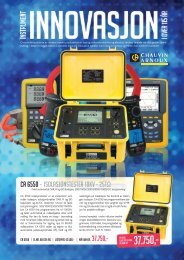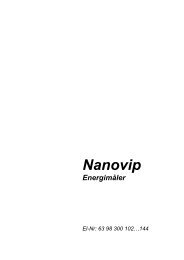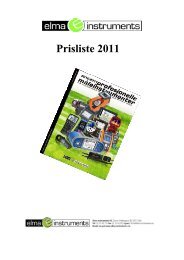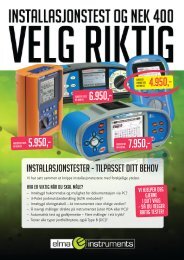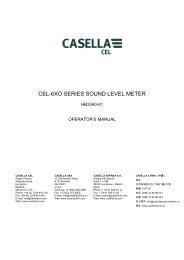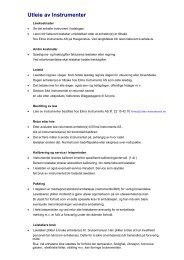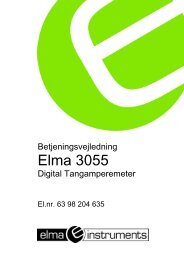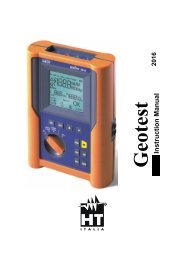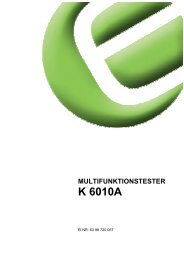Speech Intelligibility - Elma Instruments
Speech Intelligibility - Elma Instruments
Speech Intelligibility - Elma Instruments
- No tags were found...
You also want an ePaper? Increase the reach of your titles
YUMPU automatically turns print PDFs into web optimized ePapers that Google loves.
Application NoteTechnical MethodsAlready back in 1940, Bell Laboratories started to develop measurementtechnologies to determine the speech intelligibility.Nowadays, highly developed algorithms as SII (<strong>Speech</strong> <strong>Intelligibility</strong>Index) and various forms of the STI (<strong>Speech</strong> TransmissionIndex) allow measuring speech intelligibility. These techniquestake care of many parameters which are important for intelligibilitysuch as:• <strong>Speech</strong> level• Background noise level• Reflections• Reverberation• Psychoacoustic effects (masking effects)The basic idea of STI measurement consists in emitting a synthesizedtest signals instead of a human speakers voice. The speechintelligibility measurement acquires and evaluates this signalas perceived by the listeners ear. Extensive investigations haveshown the relationship between the alteration of speech characteristicsand the resulting speech intelligibility. These findingsare incorporated into the speech intelligibility meter that is ableto display the intelligibility result as a single number between 0(unintelligible) and 1 (excellent intelligibility).Figure 2: <strong>Speech</strong> <strong>Intelligibility</strong> may be expressed by a single number value. Two scalesare most commonly used: STI and CIS (Common <strong>Intelligibility</strong> Scale)www.nti-audio.com Page 3 / 14
Application Note<strong>Speech</strong> modelFirst of all, measuring the speech intelligibility requires a modelfor speech signals. For instance, speech may be described as atime evolution of various spectra. Superposition of all spectrasdefines the long-term speech frequency spectrum. Evolution intime is modulated as a set of intensity modulation.Figure 3: Average octave band spectrum ofa male speakerTime modulationLevel of frequency components varies, i.e. is “modulated” by thespeaker. Figure 4 shows the envelope of a speech signal in the250 Hz octave band. The shape of the envelope is given by averagingthe time evolution of the speech contents.Figure 4: Envelope of a speech signal (250Hz band).Frequency spectrumFigure 5: Frequency spectrum of the envelope(250 Hz band).The spectral analysis of a male voice averaged over a longer timeresults in a typical characteristic as shown in Figure 3.Analyzing the spectra of time modulation intensity shows that aspeaker modulates the speech spectra with frequencies in therange from 0.1 to 24 Hz. A set of modulation frequencies from0.63Hz to 12.5Hz sufficiently represents these modulations.Modulation Transfer Function (MTF)High speech intelligibility needs the spectral intensity modulationand the overall spectrum being preserved at reaching the listenersears. Therefore, the three core intelligibility measurement methodsSTI, RASTI and STI-PA are based on measuring the MTFs(Modulation Transfer Functions) in 7 octave bands. For each octaveband is one MTF quantifying the preservation degree of theintensity modulations in this band. These functions quantify howmuch the intensity modulations are preserved in 7 octave bandscovering the long-term speech spectrum.www.nti-audio.com Page 4 / 14
Application NoteReverbReflectionsModulated Octave Band NoiseModulation Index = 1Resulting signalModulation Index = 0.5Modulation Transfer Function for one octave bandReverbReflectionsFigure 6: Reverberation, background noise and reflection are responsible for degradingof the modulation index.Figure 7 shows the MFT of one octave band. This is derived fromModulated Octave measuring Band Noise the 1/3rd octave modulation frequencies, Resulting thus result-signaingin = 141frequencies between 0.63 and 12.5 Hz. Each Modulation modulation Index = 0.5Modulation Indextransfer function determines how well the modulations are preservedin the associated octave band.Modulation Transfer Function for one octave bandFigure 7: Modulation Transfer Function for one octave bandBased on the MTF results as well as sound pressure level, octaveband depending hearing threshold, frequency response andpsycho acoustic effects (masking effects) it becomes possible toreliably determine the preservation of speech intelligibility fromspeaker to listener. The calculations are based on extensive andprofound evaluations and comparisons with subjective methods.Measuring the complete MTF – as required for STI – can becomerather time consuming. For instance, 14 * 7 = 98 individual measurementsmust be executed, thus resulting in a total acquisitionduration of 15 minutes. Therefore, different approaches have beendeveloped to reduce test duration and to enable speech intelligibilitymeasurements with portable instruments.www.nti-audio.com Page 5 / 14
Application NoteSTI - <strong>Speech</strong> Transmission IndexThe STI result is based on the full set of 98 measurements. Sincethis approach requires a rather long test period, it is less frequentlyapplied in practice. However, STI represents the most detailedmethod to measure the preservation of speech intelligibility duringtransmission and is mostly used if alternative approachesdon’t provide reliable results due to unfavorable environmentalconditions.Figure 8: STI considers all 14 modulation frequencies and all 7 octave bands resulting in98 modulation index results.In practice, the STI result is mostly calculated from the impulseresponse (MLSA) that has been acquired e.g. with a PC-basedsystem. This approach is much quicker, but requires post-processingwith spectral frequency weighting and lot of experience.The measurement assumes a linear behavior of the setup, i.e.there must be no non-linear processing or conditions, includingcompressors or limiters and close to zero wind speeds, which isa rather rare situation. Microphone and speakers aren’t allowedfor movements during measurement. As handheld instrumentsaren’t fixed during measurement, it doesn’t make sense to supportMLS testing in handheld instruments.RASTI - Room Acoustics <strong>Speech</strong> Transmission IndexRASTI has been developed for special cases, such as a humanlecturer speaking into a small room without echo’s, but not forelectro-acoustic systems.In order to cope with the long test time required for each STI measurement,a faster method called RASTI was developed. But thisin turn weakens its ability for comprehensive testing and heavilycompromises its resistance against outside interference. This alsoleads to poor correlation between subjectively evaluated STI andRASTI. However, RASTI used to be the only method to measurethe quality of speech transmission with a portable instrument fora long time, thus it has been utilized in the aviation industry tomeasure public announcement systems, disregarding the abovementioned development restrictions of RASTI.RASTI acquires only few segments of a complete MTF table, whichwww.nti-audio.com Page 6 / 14
Application Noteobviously represents an extreme simplification of STI. Therefore,tight restrictions must be met to acquire reliable speech intelligibilityresults with RASTI. Furthermore, the RASTI result does notconsider significant parameters such as the frequency response,echoes or frequency-dependant reverberation times. For a RAS-TI measurement, only two simultaneously generated frequencybands are considered, i.e. the 500 Hz and the 2 kHz band whichthen are modulated with four and five frequencies respectively.Figure 9: RASTI uses 9 different modulation frequencies in 2 octave bands. The yellowmarked octave bands and modulation frequencyThe practical application of RASTI is mainly restricted to quantifythe intelligibility index of the channel between two persons. However,RASTI used to be the only method to measure the speechintelligibility with a portable instrument for a long time, thus it hasbeen utilized in the aviation industry to measure public announcementsystems.STI-PA - <strong>Speech</strong> Transmission Index for Public AddressA rising awareness for security issues, new technological meansand the shortcomings of RASTI triggered the speaker manufacturerBose and the research institute TNO to develop a new methodfor speech intelligibility measurements of PA installations. Theresult of these efforts is STI-PA, which allows quick and accuratetests with portable instruments.Like RASTI, STI-PA applies a simplified procedure to calculate theMTF. But STI-PA determines one MTF by analyzing all seven frequencybands, whereby each band is modulated with two frequencies.Figure 10: The IEC60268-16 describes a STI-PA method where the 125Hz band and250Hz band are combined and the yellow marked modulation frequencies are not considered.www.nti-audio.com Page 7 / 14
Application NoteSupposing that no severe impulsive background noise is presentand that no massive non-linear distortions occur, STI-PA providesresults as accurate as STI. If however impulsive background noiseis present during the normal system operation hours, it is usuallypossible to mitigate the effects by also acquiring a measurementat a more favorable time e.g. under slightly different conditions inthe area, or during the night time - and to calculate an unbiasedoverall measurement by using the results of both test cycles.Figure 11: The NTi Audio-STI-PA method (verified by TNO) considers all 7 octave bandsand all 14 modulation frequencies resulting in slightly more accurate results than the IECSTI-PA method.How does STI-PA compare to STI and RASTISTI measured in public address systems has been very timeconsuming. A complete set of 98 measurements of modulationtransfer functions (MTF) has to be obtained and summed. Due tothe complex nature and the time required almost no really usefulSTI measurement systems were available for years. With the appearanceof MLS based systems, STI was more often obtained,as it can be calculated out of the transfer function, as long asthe entire system is strictly linear and synchronous, i.e. theremust not be any non-linear processing or conditions, includingcompressors or limiters and close to zero wind, which is a ratherrare situation. Microphone and speaker aren’t allowed for movementsduring the measurements, which prohibits employmentof handheld instruments. Thus it doesn’t make sense to supportMLS measurements in handheld instruments. Alternatively by usingthe dedicated STI-PA test signal, measurements can be accomplishedwith handheld instruments.STI-PA, a derivative of STI, has been developed specifically to copewith the non-linear processing environment common to advancedsound systems, and to reduce the measurement time required toa practical level.www.nti-audio.com Page 8 / 14
Application NoteCalculation of % Alcons from STI-PA MeasurementAlcons (%) = 10^((1-STI)/0.45)The calculation of STI-PA based on Alcon measurements is notreasonable due to the difference in the measurement principles.Now STI-PAA rising awareness for security issues, new technology, and theshortcomings of RASTI together triggered the speaker manufacturerBose and the research institute TNO to develop a newmethod for measuring the quality of speech transmission of PAinstallations. The result of these efforts is STI-PA, which supportsfast and accurate tests with portable instruments. STI-PA standsfor <strong>Speech</strong> Transmission Index for Public Address systems.Portable STI-PA analyzers, e.g. NTi Audio’s XL2 Audio and AcousticAnalyzer, are able to evaluate speech intelligibility within 15seconds per room position and are thus well suited for wide-areameasurements and high productivity.Who can and should conduct STI-PA measurements?Even though the background of the STI-PA method is complex,the operation of STI-PA using the XL2 Audio and Acoustic Analyzeris very simple. Operators with a basic acoustic knowledge caneasily conduct these measurements. The instrument’s internalstorage functionality also simplifies the measurements in largerbuildings, where many measurements at many locations mustbe taken. The detailed access to the measured MTF (ModulationTransfer Function) matrix enables experts to post-process all measurementdata.Is this a research product or widely used?STI-PA is the standardized result of extensive scientific research.But unlike RASTI, within two years as many as four internationaltest instrument manufacturers have implemented the STI-PA approachand offer varying solutions. It is therefore perfectly validto say that STI-PA is the widely accepted standard for measurementsof the quality of speech transmission, combining the accuracyand advantages of full STI measurements with the benefitof extremely short measurement time of only 15 seconds perlocation.www.nti-audio.com Page 9 / 14
Application NoteWho is TNO?TNO is a research and certification institute in the Netherlands,Europe. They are focusing on research around defense, securityand safety and they have originally developed the STI as well asthe STI-PA technology. Their knowledge is freely useable and notpatent protected.Compatibility?Thanks to TNO, acting as a certification body, it is guaranteed thatinstruments from all certified test and measurement vendors willprovide compatible measurement results. Three vendors are currentlycertified by TNO. Studies and comparisons conducted byPeter Mapp Associates, Colchester, Essex UK, confirmed that allcertified vendors provide stable and comparable measurementresults. Details of the comparison may be found in the AES publicationtitled “Is STI-PA a robust measure of speech intelligibilityperformance?”Patent protected?Even though the research part of STI and STI-PA is not patentprotected, BOSE of America has been recently been granted theUS-Patent 6,792,404B2 for the idea to implement STI or STI-PAonto a hand held analyzer. NTi Audio maintains a license agreementwith BOSE for this patent and is therefore able to marketthe STI-PA implementation available for the XL2 Audio and AcousticAnalyzer in the US.Can I buy STI-PA for my XL2?Yes, STI-PA is an optional function for the XL2 Audio and AcousticAnalyzer. Any XL2 user may obtain a STI-PA license. With the keyof the license he may request the activation key for his XL2 Audioand Acoustic Analyzer and full functionality is then activated.What is a TalkBox? / Do I need a TalkBox for STI-PA?The TalkBox is NTi Audio‘s calibrated acoustical sound source withbuilt in digital solid state signal generator. You don’t necessarilyneed a TalkBox if you are testing only the portion of the systembeyond the microphone. But the use of the NTi Audio TalkBox asspeaker substitute is advisable if:• Regulations require a complete end-to-end system check in-www.nti-audio.com Page 10 / 14
Application NoteNTI TalkBoxcluding the microphone. This is the most realistic system checkin any event.• No electrical input is available to induct the electrical test signal.• The level of the test signal is not clearly defined• The characteristics of the speaker’s acoustical environment arenot negligible and flat.• The characteristics, sensitivity and frequency response of thespeaker’s microphone is not known but needs to be considered.• As above, if for any other reason it is desirable to test the entiresignal chain under real conditions.• The TalkBox is also capable of delivering white and pink noiseand other special signals, and so is a very useful overall tool forsystem tuning and testing.STI-PA Test Result• The intelligibility index is measured in the range from 0 to 1,whereby 1 is perfect and the minimum requirement includingmeasurement uncertainty and variation is >= 0.5.• The variation of STI-PA test results shall be smaller than 0.03STI at one test position, thus to fulfill measurement conditionsfor ambient noise characteristics. The actual variation shall bemeasured at a representative location.• Best intelligibility is achieved at message levels in the rangeof 70-80 dBSPL. At higher sound pressure levels the selfprotectionof the ear comes into action, which is reflected ina reduced intelligibility index, such as a STI of 1 at 70 dBSPLmay be down to 0.7 STI at higher sound pressure level.• Based on the random STI-PA test signal the typical variationsof the measurements is 0.01 – 0.03 STI. Thus at applicationswith STI-PA values < 0.63 STI the measurement has to berepeated twice and the arithmetical average of all 3 measurementscalculated.• In case variations are higher than 0.03 STI, further 3 measurementshall be carried out and all 6 readings arithmetical averaged.• In case variations at the same test location are higher than0.05 STI, causes for these discrepancies shall be detected,eliminated and the measurement repeated.www.nti-audio.com Page 11 / 14
Application NoteSTI-PA Measurement Hints• Any background noise has to be sufficiently static during themeasurement, e.g. pink noise fulfills this requirement.• Verify the environmental conditions prior testing. CompleteSTI-PA measurements without any test signal. The results shallbe < 0.20 STI.• Impulsive background noise during the measurement, such asspeech, cause severe measurement errors. The STI-PA resultis usually too high.• In case such an impulsive noise cannot be prevented, the measurementsmight be shifted e.g. to night time, and afterwardscorrected with the averaged daily background noise, usingexternal post processing.• Any CD-Players used to reproduce the STI-PA test signal haveto be accurate as only limited time-shifts (+/- 200 ppm) areallowed to ensure reliable STI-PA test results. Pitch controland shock protection shall be disabled. Thus only professionalplayers shall be used. You may verify the time shift of your CD-Player with a 1 kHz test signal:• Insert the NTi Audio Test CD into the CD player and start track1, which is the 1 kHz test signal.• Connect the XL2 directly to the audio output and measure thesignal frequency in the RMS/THD mode. The displayed frequencyshall be in the range from 0.9998 kHz to 1.0002 kHz• STI-PA test signals of other test system manufacturers maysound similar but are not compatible. Only the NTi Audio STI-PA test signal CD V1.1 or higher shall be used in combinationwith the XL2.• STI-PA measurement of alarm systems should be carried outat emergency conditions (same sound pressure level and allcomponents are activated).• At locations with varying conditions e.g. some public areaswith few people; others with crowds -- the worst case STI-PAresults should be measured. Consult your local regulations(e.g. in the U.S., the NFPA code) for specific directives concerningmeasurement locations and number of required totalSTI-PA measurements under different circumstances.• Select typical locations based upon such regulations, or typicallyposition the microphone at 1 - 1.2 meters above groundin sitting areas or 1.5 - 1.8 meters in standing areas (typicalmeasurement positions are normally not directly in front of thespeakers).www.nti-audio.com Page 12 / 14
Application Note• The person taking the measurements should be out of theacoustic field, so not affecting the measurement results. Forthis purpose the measurement microphone can be mountedon a microphone stand and connected with the ASD-Cable tothe XL2.• Low STI-PA readings can be caused by• Excessive sound reverberation, echoes or reflections• Poor speaker directivity or speaker coverage• Speaker power setting not in order (e.g. low signal-to-noiseratio)STI-PA Post ProcessingMeasuring the speech intelligibility index under realistic environmentconditions is often not applicable, e.g. playing the test signalin a railway station at emergency levels during peak hours will irritatepassengers. Additionally at rush hours the characteristics ofback ground noise might be highly impulsive. But a pre-requisitefor accurate STI-PA measurements is a negligible impulsivity inthe background noise.Under such circumstances the STI-PA measurement should beshifted to a more suitable time of the day, e.g. night time. SuchSTI-PA measurements taken at untypical background noise conditionshave to be post-processed. Post processing combinesthe STI-PA measurement data taken at quasi noise-free ambientconditions with the unweighted time-averaged octave band noiselevels (Leq) taken e.g. during day time, at realistic environmentalconditions.The NTi Audio STI-PA Post Processing Software is tailored forthis application e.g. to combine the night and day-time measurement.“NTi_Audio_STI-PA_PostProcessing.xlt” is available for downloadat “www.nti-audio.com/XL2”(Enable all macros at opening the document.)www.nti-audio.com Page 13 / 14
Application NoteWhat to do if Impulsive Noise is permanently present?In a 24 hours factory or on a highway impulsive noise may be permanentlypresent, thus STI-PA measurements shall not be carriedout. In such instances the onsite conditions have to be simulatedin a laboratory for STI-PA testing:• The real noise spectrum shall be measured e.g. with the XL2Audio and Acoustic Analyzer SLM function, averaging over asufficient amount of time.• A diffuse sound field of non-impulsive noise with same frequencyshape and octave band levels as measured has to begenerated in the laboratory.• The real speaker - listener situation has to be reproducedacoustically in the laboratory as close as possible.• Then the actual STI-PA measurement can be carried out. Nopost processing is required.This approach will also be mandatory for systems including automatedgain control (AGC), if they can’t be tested in the original environmentdue to annoyance of people exposed to the test signaldue to the impulsive background noise.Further Information:For further information please visit www.nti-audio.com.Detailed information on speech intelligibility measurements arecontained in the IEC60268-16 (2003-5) standard, which also describesthe test procedures and the requirements in practice.www.nti-audio.com Page 14 / 14




